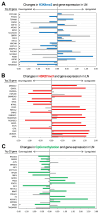Promoter H3K4me3 and Gene Expression Involved in Systemic Metabolism Are Altered in Fetal Calf Liver of Nutrient-Restricted Dams
- PMID: 40806668
- PMCID: PMC12347666
- DOI: 10.3390/ijms26157540
Promoter H3K4me3 and Gene Expression Involved in Systemic Metabolism Are Altered in Fetal Calf Liver of Nutrient-Restricted Dams
Abstract
Maternal undernutrition (MUN) causes severe metabolic disruption in the offspring of mammals. Here we determined the role of histone modification in hepatic gene expression in late-gestation fetuses of nutritionally restricted cows, an established model using low-nutrition (LN) and high-nutrition (HN) conditions. The chromatin immunoprecipitation sequencing results show that genes with an altered trimethylation of histone 3 lysine 4 (H3K4me3) are associated with cortisol synthesis and secretion, the PPAR signaling pathway, and aldosterone synthesis and secretion. Genes with the H3K27me3 alteration were associated with glutamatergic synapse and gastric acid secretion. Compared to HN fetuses, promoter H3K4me3 levels in LN fetuses were higher in GDF15, IRF2BP2, PPP1R3B, and QRFPR but lower in ANGPTL4 and APOA5. Intriguingly, genes with the greatest expression changes (>1.5-fold) exhibited the anticipated up-/downregulation from elevated or reduced H3K4me3 levels; however, a significant relationship was not observed between promoter CpG methylation or H3K27me3 and the gene set with the greatest expression changes. Furthermore, the stress response genes EIF2A, ATF4, DDIT3, and TRIB3 were upregulated in the MUN fetal liver, suggesting involvement of the response in GDF15 activation. Thus, H3K4me3 likely plays a crucial role in MUN-induced physiological adaptation, altering the hepatic gene expression responsible for the integrated stress response and systemic energy metabolism, especially circulating lipoprotein lipase regulation.
Keywords: epigenetics; fetal growth restriction; histone modification; integrated stress response; liver; maternal undernutrition; metabolic programming.
Conflict of interest statement
The authors declare that there are no conflicts of interest.
Figures





Similar articles
-
One-carbon metabolite supplementation increases vitamin B12, folate, and methionine cycle metabolites in beef heifers and fetuses in an energy dependent manner at day 63 of gestation.J Anim Sci. 2024 Jan 3;102:skae202. doi: 10.1093/jas/skae202. J Anim Sci. 2024. PMID: 39028746 Free PMC article.
-
Late gestation maternal overnutrition alters gene expression and histomorphology in neonatal foal testes.J Anim Sci. 2025 Jan 4;103:skaf060. doi: 10.1093/jas/skaf060. J Anim Sci. 2025. PMID: 40036360
-
Late gestational nutrient restriction decreases placental size and calf birth weight without altering uterine blood flow in primiparous beef females.J Anim Sci. 2025 Jan 4;103:skaf163. doi: 10.1093/jas/skaf163. J Anim Sci. 2025. PMID: 40355365 Free PMC article.
-
NTP Developmental and Reproductive Toxicity Technical Report on the Prenatal Development Studies of 2-((1-(4-Phenoxyphenoxy)propan-2-yl)oxy)pyridine (CASRN 95737-68-1) in Sprague Dawley (Hsd:Sprague Dawley® SD®) Rats and New Zealand White (Hra:NZW SPF) Rabbits: DART Report 07 [Internet].Research Triangle Park (NC): National Toxicology Program; 2022 Jan. Research Triangle Park (NC): National Toxicology Program; 2022 Jan. PMID: 35593777 Free Books & Documents. Review.
-
Maternal and neonatal outcomes of elective induction of labor.Evid Rep Technol Assess (Full Rep). 2009 Mar;(176):1-257. Evid Rep Technol Assess (Full Rep). 2009. PMID: 19408970 Free PMC article.
References
-
- Govoni K.E., Reed S.A., Zinn S.A. Cell Biology Symposium: Metabolic Responses to Stress: From Animal to Cell: Poor maternal nutrition during gestation: Effects on offspring whole-body and tissue-specific metabolism in livestock species1,2. J. Anim. Sci. 2019;97:3142–3152. doi: 10.1093/jas/skz157. - DOI - PMC - PubMed
Grants and funding
LinkOut - more resources
Full Text Sources
Research Materials
Miscellaneous

